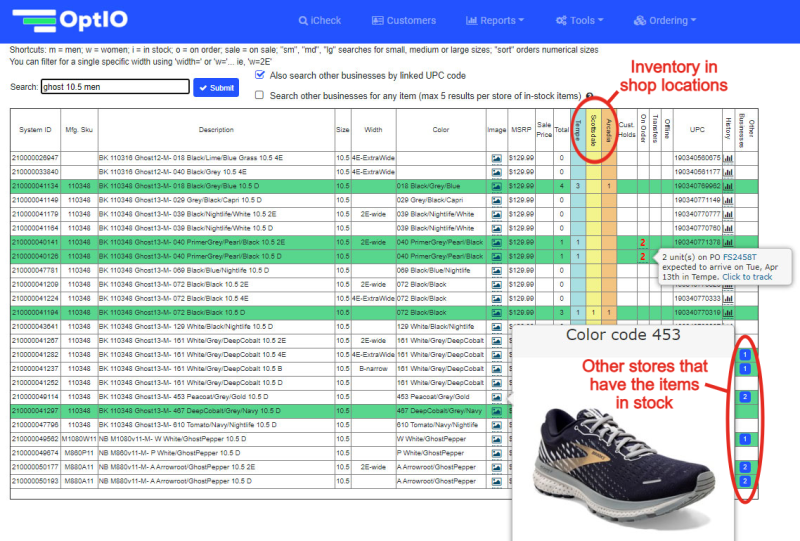Frustrated by the challenges and inefficiencies in existing inventory management processes, especially for independent run specialty retailers, Lance Muzslay, co-owner with Karen McDonnell of the three Sole Sports Running Zone stores in Arizona, set out a few years back to develop a suite of tools that stands to revolutionize inventory management and overall efficiency for run specialty retailers.
The result is Optio, which he describes as a browser-based suite of inventory management software geared toward running stores that significantly streamlines every aspect of inventory management. It does so by striking a balance between automating tedious and laborious tasks while allowing for quick and efficient decision making.
Essentially, Optio integrates all relevant inventory data in real time and delivers it in an easy-to-use and actionable manner. And with the advent of cloud-based POS systems it became possible to offer this suite of tools to other retailers so that they too may alleviate stubborn pain points.
The Option Evolution
For many years Muzslay worked as the buyer and saw many gaps in the functionality of POS systems, especially for footwear retailers. Necessity being the mother of invention, he then recognized that Sole Sports’ ability to grow depended on the development of tools that plugged these gaps. With a background in software development in addition to being a footwear buyer, he was uniquely positioned to pursue his vision of tools that would bring extraordinary efficiency to small retailers.
“I’m not aware of anything else that is as comprehensive and efficient to use, because if there was then I probably wouldn’t have created Optio,” Muzslay tells Running Insight, pointing out that most retailers are already using some mix of POS reports and custom spreadsheets to assist in buying decisions and managing inventory. Optio handles the painful, messy stuff and delivers actionable information on a silver platter in an easy to use format.
The technology that would eventually form the basis of Optio was many years and refinements in the making and Muzslay explains that as a buyer for Sole Sports he started developing these tools to make the buying process more efficient.
“I was surprised to discover just how daunting it is to manage inventory efficiently with so many styles, sizes, colors and locations along with product flowing in and out daily,” he recalls, adding that over time Optio expanded to cover all aspects of inventory management such as balancing inventory among multiple locations, special orders tracking, inventory counting and inventory searching.
“Experiencing firsthand the tremendous difference this made for Sole Sports and encouraged by positive feedback from our staff and colleagues in the specialty running channel, it made sense to make Optio available to the entire industry so that other stores can share in the same efficiencies that Sole Sports has achieved,” Muzslay explains.
How Optio Works
To understand how Optio works, Muzslay says there are three primary areas of benefit.
- Buying for both at-once and future orders. The footwear at-once order report computes exactly what needs to be ordered based on real time inventory from all locations, purchase orders due to arrive soon and stock levels defined for each style, size and location.
The future order revision report computes a suggested range of quantities for each style and size based on current inventory and historical sales. Finally, the future order generator report drafts orders for a new season based on historical sales from a similar time period.
- Enhancement of existing POS features. An inventory search engine makes looking up inventory much easier than the search functions built into any POS and even features automatic image rendering for several key brands, which is enormously beneficial to stores with multiple locations.
One unique feature built into the inventory search engine is the ability to search across other stores that have opted in to connect their inventory data, a feature that is becoming very popular given the increasing supply chain issues our channel is facing.
For instance, when vendors cannot fulfill a special order it’s a relief to find another store who is willing to sell it. This has been done for a long time through e-mail chains and among stores friendly to one another, but those modes are time consuming and woefully inefficient. Optio’s virtualization of inventory across many businesses puts retailers in a better position to save sales that might otherwise have been lost by a customer leaving to purchase online.
The inventory counting feature gives the person scanning barcodes an audible alert after every barcode scan indicating whether or not it matched an item in their database. It also allows scanning barcodes faster than Lightspeed Retail does. Similar features exist for receiving purchase orders and creating inter-store transfers.
The special orders report consolidates special orders across all locations and puts into buckets such as needs to be ordered, needs to be contacted, needs to be transferred to another location. This is certainly more efficient than a spreadsheet or paper notebook.
- Inventory distribution for stores with multiple locations. The transfers report computes a pick list of what needs to be transferred from one location to another based on stock levels and real time inventory.
The first priority is filling holes where there are no shoes for a particular size of a style. Next is balancing quantities and colors across locations so that customers have the widest range of choices. Balancing inventory is often done relatively manually and is terribly time consuming.
Vendor Benefits and Retail Implementation
Benefits of the system extend beyond the retailers themselves to their vendors, because when stores manage their inventory and purchasing more efficiently vendors are provided with better inventory predictability.
“Purchasing can be pretty erratic because the existing tools are cumbersome and inefficient,” Muzslay explains. “Optio is an antidote to that chaos and empowers retailers to be better partners.”
The biggest benefits are seen with footwear, followed by accessories. “Footwear presents a unique challenge with regards to ordering and for stores with multiple locations, distributing among multiple locations, because colors often need to be rolled up across styles,” he points out.
Retailers need not be intimidated by the technology, he stresses, since Optio integrates with RICS and Lightspeed Retail as a cloud-based service. Once authentication is done the data automatically refreshes from the POS system in the background.
“It’s been designed to be very user friendly and doesn’t take users very long to get comfortable with its features,” he says, adding that other POS system integrations will be developed upon request.
One other vendor benefit is that users have the ability to create accounts for sales reps in which they are empowered to view sales and inventory data for only the brands they represent. This is beneficial for sales reps to be able to see how their brand is performing in real time without having to rely on getting reports emailed to them.
A free 60-day trial is available to any store that uses RICS or Lightspeed. Pricing is $10 a month per $100,000 in annual sales; a store doing $750,000 per year would pay $75 a month.
“The amount of money saved through time savings and increased profitability will be many multiples of the cost,” Muzslay promises. “You could say that it’s one of those things that needs to be seen to be believed.”
What’s Next for Optio
As he rolls out Optio industry-wide, Muzslay says the next priority is integrating vendor inventory availability data.
“It’s laborious to have to log into a vendor’s B2B site in order to check availability of items, especially when a store is busy and a customer is asking to place a special order,” he explains. “One step further will be adding the ability to create purchase orders inside of Optio while viewing vendor availability data.”
Automatic computation of stock levels for accessories based on targeted turn rates and sales velocity is also on the drawing board. With hundreds or thousands of accessory SKUs being stocked, it’s not practical to stay on top of stock levels through a manual process. A better solution is specifying a turn rate target by item or category and then computing the stock level needed to achieve that based on historical sales.
Finally, a big feature under development is integrating a sophisticated business intelligence platform that will enable dashboards and nearly any report someone can dream up. Muzslay also plans to develop reports by anonymizing data across all Optio users so that trends can be highlighted and best practices shared.
“Reducing friction while improving precision in operations is the driving force of Optio,” he explains.
Lance Muzslay can be reached at [email protected]. Key features are highlighted at www.getopt.io.






